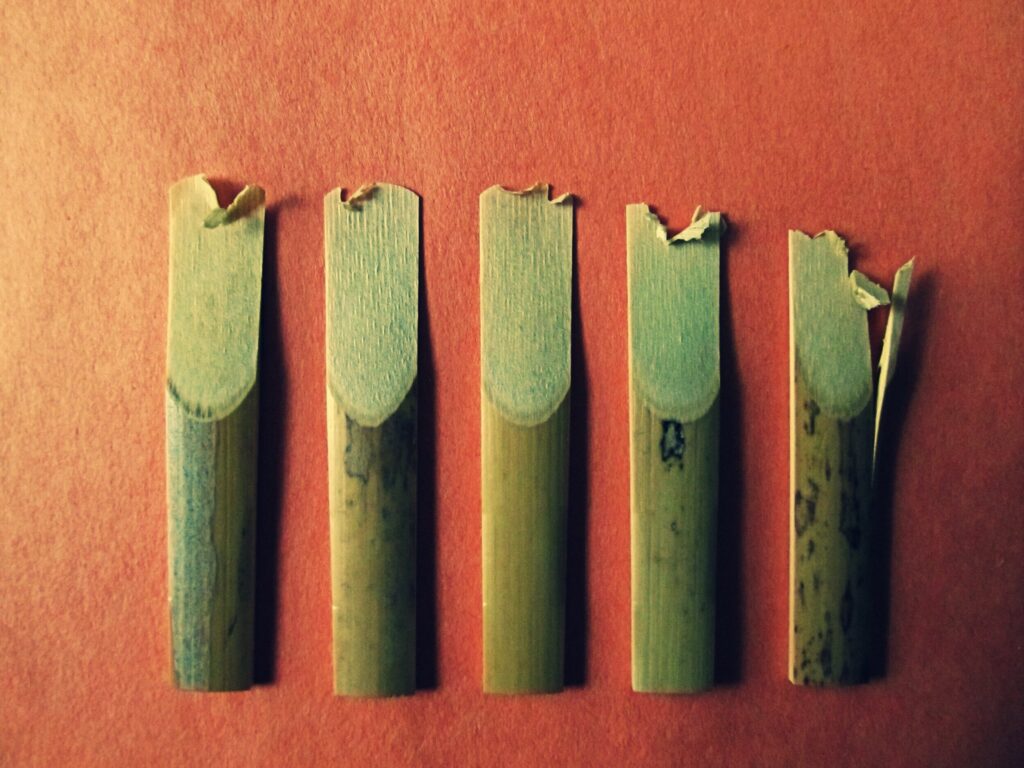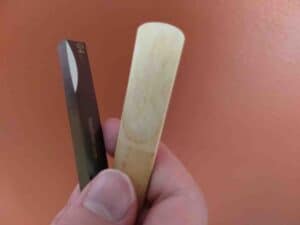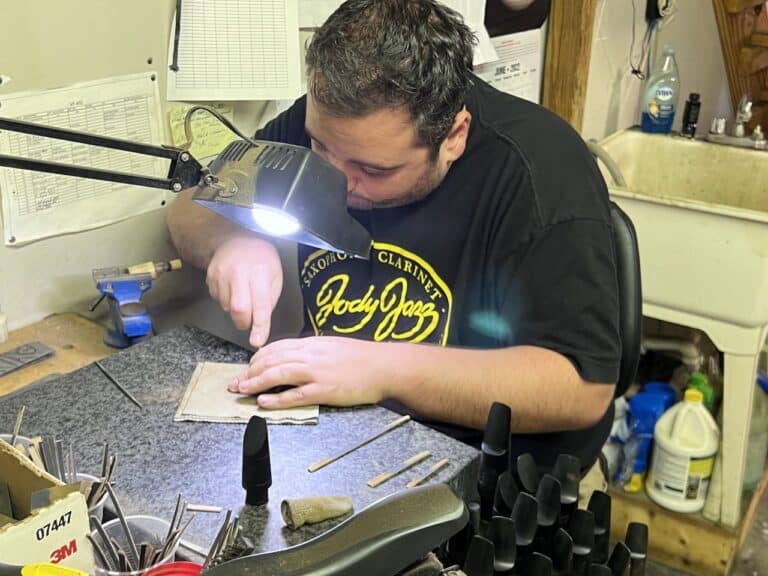Why Does My Saxophone Sound Airy?
Having an airy sound can be frustrating, and it can happen even to the best of saxophonists. Unfortunately, it is also somewhat difficult to diagnose the cause, because an airy sound can be produced by a variety of different factors. There are, however, a few causes which tend to be the most common.
An airy sound is usually caused by a reed which is either too hard or unbalanced. It is also common for an airy sound to be caused by leaks in the instrument. Less often, an improper placement of the reed or ligature on the mouthpiece, a poor embouchure, a low-quality mouthpiece, or a broken octave mechanism may cause airiness. The solution to an airy sound varies based on the cause.

My goal is to offer you a comprehensive guide to determining why you have an airy sound and to offer you a solution based on the cause.
| Cause of Airiness | Diagnosis | Solution | Commonality |
| A leak | Everything below a specific note is airy or resistant | Take your horn to a repair shop | Very common |
| *A dry, stiff, unbalanced, or warped reed | Try using a high-quality plastic reed | Buy high-quality reeds, break them in properly, store them well, and study reed modification | *The most common |
| Improper placement of the reed or ligature on the mouthpiece | Reed and mouthpiece look unaligned | Align the edges of the reed to edges of the flat surface of the mouthpiece | Somewhat common, especially among beginners |
| Mouthpiece is too open or otherwise low-quality | No good method, but it is a possibility if you are using a cheap plastic mouthpiece | Buy a high-quality rubber mouthpiece | Not common |
| Poor embouchure or air support | The air seems to be leaking from corners of your mouth | Make sure you are using proper embouchure; have a good teacher | Not common, but may happen to beginners |
| Octave mechanism isn’t working | Focus on the tone quality of your G and A (in both octaves). | Take your horn to a repair shop | Not common |
Cause #1: A leak

If you want to know why your saxophone is sounding airy, then there is one specific question you need to answer first: does the full range of your saxophone sound airy, or are there some notes which sound airy and some which do not?
If there are only a few notes which sound airy, then you are probably dealing with a leak. It is, for instance, incredibly common for the G# key to leak. This will cause airiness and resistance on everything below G# (though perhaps not on the G# itself).
The surest indicator that you are dealing with a leak is if everything above a particular note sounds fine, but everything below that note sounds airy.
Leaks can be especially frustrating when they occur in a palm key. If this is the case, you will notice that the high notes all seem to play fine, but you might gradually encounter more resistance and airiness as you go lower in the range of the instrument.
Sometimes it can be hard to tell whether or not airiness is caused by a leak or not. The best way to determine this is to play on an instrument other than your own. Use the exact same setup of reed and mouthpiece, but play on a saxophone other than your own (preferably one that you know to be functional). You might be able to use a friend’s saxophone for this purpose; provided that you are still using your own mouthpiece and reed, there shouldn’t be any sharing of germs.
If you are still encountering the same resistance on a different saxophone, then the culprit is probably not a leak. If, on the other hand, using a different instrument makes the problem go away entirely, then it is probably time to take your saxophone into a repair shop.
One other way to check for a leak is to point a flashlight into the top of the instrument, where the neck would usually go. Then close all the keys on the instrument, and see if any light gets through the keys. If it does, then that is indicative of a leak. You may have to be in a dark room to get this to work, though.
Unfortunately, there is not typically any good DIY way to eliminate leaks. It is best to find a good repair person, specifically one who specializes in saxophones (or even just woodwinds in general) if you are able.
Many repair jobs done by individuals who do not specialize in the instrument they are repairing can often prove to be inadequate. Just because an instrument has been “fixed” does not mean that the cause was not a leak if the problem persists, nor does it mean that the leak is not still there.
Cause #2: A dry, stiff, unbalanced, or warped reed

This is the cause which I have found to be the most common when dealing with an airy sound. If your saxophone is airy in general but not over a specific range, then you are probably dealing with reed issues. The problem with reeds is that they perform so inconsistently that even the best brands can sell boxes of reeds where half of them are too hard and sound airy.
If you think the issue might be dryness, then try briefly submerging the reed in water before playing it. Otherwise, a good way to check whether the cause of your airy sound is due to your reed is to try using a plastic reed. Though some feel that plastic reeds do not sound as good as the best cane reeds, it is nonetheless true that plastic reeds are made with a high amount of consistency, and will almost never sound airy.
So, if you don’t have a plastic reed, I recommend you go buy yourself one. You will know for sure whether or not the problem of airiness is due to the reed, and you’ll also have a good backup reed that can last you a solid year if you take care of it.
The brand of plastic reeds which I recommend and have used for years is the Legere Signature model. They might not sound quite as good as the best Vandoren cane reeds, but they come pretty close and play much more consistently.
If you use a Legere Signature reed and the instrument still sounds airy, then the problem is probably not your reed. If, on the other hand, the plastic reed seems to solve the issue completely, then you’ve probably found the issue.
Of course, you presumably still want to be able to use your cane reeds. It can be difficult to turn a stiff reed into a well-functioning one, but it is possible through reed modification and properly breaking in the reed. You can find a full guide on breaking in reeds here. If you haven’t been properly breaking in your reeds before now, you might find that makes a noticeable difference.
Reed storage is also important to ensure that the reeds continue to play well and do not warp. Ideally, you should find a reed case which keeps the reeds hydrated and which keeps the reeds on a ridged or glass surface to prevent warping.
If you have been using a deliberate process to break your reeds in and have been storing them properly, you might want to study the nuances of reed modification. This can solve the issue of having reeds be too stiff or unbalanced. It isn’t an easy skill to learn, per se, but it is one which will get rid of that airy sound and help you save money on reeds in the long run.
Cause #3: Improper placement of the reed or ligature on the mouthpiece

This tends to be more of a beginner mistake, and from my experience is not typically the cause of a consistent airy sound. Nonetheless, it is important to rule out potential causes, and placing the reed and/or ligature improperly on the mouthpiece can certainly cause an airy sound.
Remove your mouthpiece from your saxophone and hold it perpendicular to the ground at eye-level. The goal here is to determine whether or not the tip of the reed is aligned with the tip of the mouthpiece. Ideally, you should see perhaps just the tiniest sliver of mouthpiece tip behind the reed. The tip of the reed and tip of the mouthpiece should be aligned as closely as possible.
If you see more than just a sliver of the tip of the mouthpiece, then you will probably produce an airy sound. Similarly, if the reed is so high on the mouthpiece that it is difficult to see the tip of the mouthpiece behind it, then you may also sound airy. Try placing your reed higher or lower on the mouthpiece, and see if that makes a difference.
Also make sure that the sides of the reed are aligned with the sides of the flat section of the mouthpiece. Failing to do so will cause air to leak out of the mouthpiece.
Placing the ligature in the wrong spot on the mouthpiece can also cause airiness. In general, you want to make sure that your ligature is placed over the thickest part of the mouthpiece. If it is placed higher or lower on the mouthpiece, the quality of your sound may decrease. It is not common for the result of this to be an airy sound, per se, but again, we want to rule out as many causes as possible.
Also make sure that the ligature is neither fully loosened nor fully tightened. You want to allow the reed to vibrate while also holding it in place.
Cause #4: Mouthpiece is too open or poorly made
This is perhaps the least common cause of an airy sound, but it is still worth considering. If you are using a cheap plastic mouthpiece which came with your beginner saxophone, you may want to consider an upgrade. Plastic mouthpieces tend to be so inconsistent that they can cause problems in many different areas of your playing. In some cases this may be an airy sound.
One of the most reliable mouthpieces is the Vandoren Optimum AL3 (AL3 is for the alto sax; use the TL3 for tenor, BL3 for bari, and SL3 for soprano). It is a professional-quality rubber mouthpiece which is easy to play on. It also has a relatively small chamber, which means that it has low resistance and is unlikely to produce a sound which is airy.
Cause #5: Improper embouchure or air support

If you feel that air is leaking out of the corners of your mouth as you play, the issue may be your embouchure rather than your instrument.
Ideally, you should imagine your lips being a rubber band on the mouthpiece. If you place a rubber band around an object, it tends to apply pressure equally on the object from all sides. Your embouchure should be the same way.
Make sure that your top teeth and bottom teeth are aligned; neither set of teeth should be further forward on the mouthpiece than the other.
Also, make sure that you take a deep breath from your diaphragm before playing. Air support is key to sounding good. This will not often cause an airy sound, but it is a possibility.
Cause #6: The octave mechanism isn’t functioning properly
Sometimes problems with the octave key can cause an airy sound. This can be the case either if the octave key is leaking, or if the mechanism is lagging behind after you press the octave key.
A good way to test for this is to alternate between playing your low A and low G. Listen carefully to your sound and do this slowly. Then, do the same exercise but add the octave key so that you alternate between the A and G above the staff.
If you notice major changes in your tone quality as you are doing this, then you may have an issue with your octave mechanism. You’ll want to get your instrument to a repair shop. As was the case with leaks, make sure that you properly vet your repair person.
Lastly, do check out this ULTIMATE guide to getting a good sound on the saxophone.






